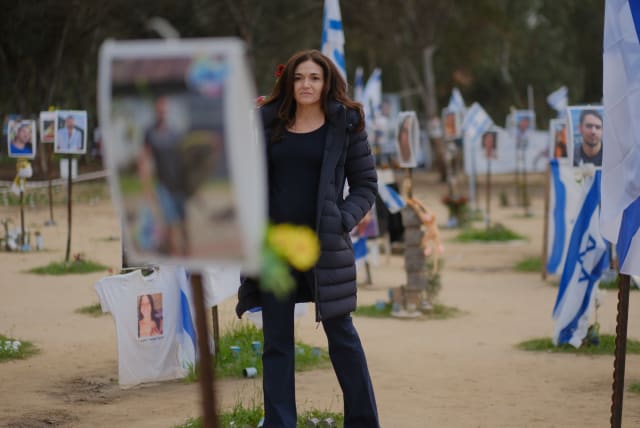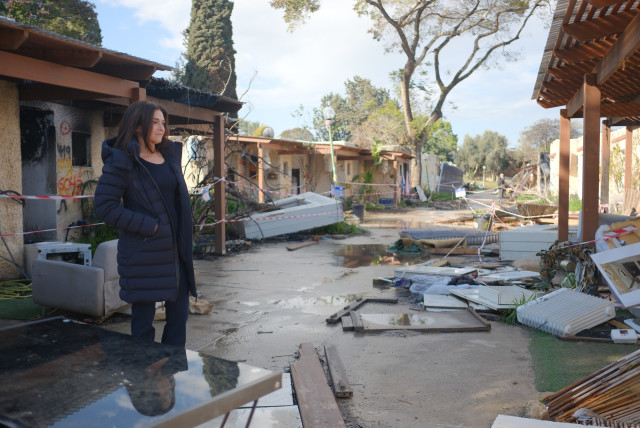'Screams Before Silence': New doc highlights Hamas's Oct. 7 sexual violence

The documentary "Screams Before Silence" exposes the sexual violence perpetrated by Hamas terrorists during the October 7 attack in Israel, amplifying victims' voices.
Sexual violence was a central part of the massacre and hostage-taking attack that Hamas terrorists carried out in Israel on October 7 and while many women’s organizations stayed silent or made weakly worded statements about it, there are still those who deny that it took place altogether.
This inspired former Facebook COO and author Sheryl Sandberg to make the compelling and important documentary, Screams Before Silence, which is now available on YouTube.
“It’s really difficult to talk about it, but . . . it’s my duty to come out and talk,” said Amit Soussana, one of the interviewees in the film. Soussana, who has also spoken about her ordeal to The New York Times, was kidnapped from her home in Israel and held hostage for nearly two months days.
She speaks in detail in the film about the sexual assault she suffered at gunpoint. While other sexual assault victims have not spoken publicly using their names, there are many witnesses and first responders who speak in the film, as well as video evidence of sexual assaults.
But the tragic truth, as this documentary makes crystal clear, is that the major reason few of the victims have come forward is that the vast majority were murdered following, and sometimes during, their assaults.
Sandberg visited Israel to make this film, which was directed by Anat Stalinsky and which in which Sandberg conducts the interviews, so that she could “let those silenced voices be heard.”
Documentary exposes Gaza assaults
Sandberg and the filmmakers put the sexual assaults into context by outlining the scope of the October 7 attack, with first responders and survivors of the massacre who witnessed rapes detailing the vast, coordinated nature of the attacks on residents of kibbutzim near the Gaza border and those attending and working at the Nova Music Festival. About 1200 people from Israel were around the world were murdered on October 7 and about 250 were taken hostage, 134 of whom are still being held in Gaza.
Out of respect for the victims and their families, the film does not contain any explicit images. But it does feature graphic descriptions of sexual violence, some of which will be quoted here, so those who prefer not to read these descriptions should stop reading now. However, I would suggest that out of respect for the women who suffered these horrors, the least most of us can do is to read about them.
It's worth noting that while the United Nations is not given to showing much sympathy for Israel, the UN’s office of sexual violence in conflict released a report in March that said it found “reasonable grounds to believe” that such assaults had been perpetrated by Hamas terrorists, and anyone who sees this documentary is likely to be convinced as well by the horrifying accounts of those who survived the massacre and those who were first on the scene.
Mirit Ben Mayor, Chief Superintendent, Israel Police, is interviewed in the film and said that the police have “over 200,000 visuals and over 2,000 testimonies we have collected . . . which show substantial evidence of sexual violence.”
Among those who are interviewed in the film is Tali Binner, who was at the music festival and survived by hiding in a trailer. She told Sandberg, “I started to hear the yelling of women. I heard a girl that started to yell for a long time. It was like, ‘Please don’t! No, no, stop, stop, stop, stop!’ ... She was asking someone to stop? What can they stop?. . . So, when I hear ... someone scream and then silence, I knew that it’s probably someone got shot. But when you hear this chaos for like 20 minutes or 15 minutes, you understand that something much worse is happening right over there. ” All around the trailer, “There were so many noises of women, of different women, not only one. I also heard a couple, she didn’t say words. Like she was just screaming, and he begged for someone to leave her [alone].” Asked by Sandberg how the screaming ended in these cases, Binner replied, “They got shot. And then silence.”
Elad Avraham, a security supervisor of Nova described seeing bodies of people to whom “inhumane” things had been done and described seeing many women with their clothes torn and their legs spread, as well as seeing obvious signs that they had been tortured and mutilated. “You see the body of a girl with her clothes torn and body parts mutilated and ripped off. So you say to yourself, ‘They raped her, slaughtered her, and also mutilated her. What more can they do to a person?’”
Certainly, anyone who would deny these abuses by Hamas might want to look at some of the videos that Hamas terrorists posted to their own social media, which are shown in this film. These include the infamous clips of Shani Louk, who was murdered at the music festival, whose body is shown in a truck with men spitting on her, and Naama Levy, one of the IDF border observers, who can be seen being pulled out of the back of a jeep by her hair, with blood in her groin area.
Her mother, Dr. Ayelet Levy Shachar, said, “The first thing you see is the terrorist drags Naama out and her face looks terrified. She’s barefoot and in her pajamas and they’re bloodstained. They’re grabbing her by the hair and she’s all messed up. And I’m thinking of her hair and like, in my mind, I’m stroking her hair like I’m always doing. And I’m thinking of what she experienced, you know, until that point. And how long was she --- “ she said, breaking off. “You know, maybe that’s the thing with that video, that we would like to think that this couldn’t be possible. That nobody would harm a young girl. But then you just see it there. They’re the one who posted that video, the Hamas.”
First responders at the massacre sites showed Sandberg photos of many women who had nails and metal objects driven into their groins and were who were shot in the vagina, as well as of a woman whose foot had been cut off and a woman who had been stabbed in her vagina and had her organs cut out. While we see Sandberg’s responses to these images, the images themselves are not shown in the film.
Simcha Greinman, a volunteer for ZAKA, the Israeli community emergency response organization, who was one of the first responders at the massacre sites, explained that although they are trained to collect body parts, “I don’t have the words to explain what we saw.”
Rami Davidian, a volunteer who rescued many from the massacre sites, said he saw dozens of naked women tied to trees, whose bodies showed signs of having been raped and mutilated before they were murdered.
We see a clip of the eyewitness who describes terrorists gang raping a naked woman and then saw one cut off her breast: “He cuts off her breast and throws it on the road and they play with it.”
It becomes clear that there was a pattern and a plan behind the sexual assaults. Haim Otmazgin, another ZAKA volunteer said, “When you see one woman and another and another all with signs of abuse in the groin area, you understand that this wasn’t a random thing.”
Shari Mendes, IDF reservist at military morgue, on the Shura base described rooms that were filled from floor to ceiling with body bags. “And we never knew what we would see, what the level of the atrocity would be inside the body bag.” Women were shot in the face so many times, “it seemed like there was an objective to obliterate their faces.” Families could not be shown the faces of their murdered daughters and there was “directly targeted sexual violence.” Female bodies were naked, or clad in underwear covered in blood. “It did seem systematic, to use sexual violence as a weapon of war.”
Prof. Ruth Halperin-Kaddari, former vice president of the UN Committee on the Elimination of Discrimination Against Women said the evidence “depicts a pattern that could not have been unless it was premeditated and preconceived by Hamas themselves. . . Using sexual violence as a tool of war . . . sadly is as old as the history of humanity, because when the body of the woman is violated, it symbolizes the body of the whole nation.”
Cochav Elkayam Levy, head of the Civil Commission on October 7 Crimes against Women and Children said, “It’s sexual abuse in its worst form. They wanted to inflict abuse in the cruelest manner possible. I think they have redefined evil and in ways that we will even need to redefine international criminal law.”
Ben Mayor noted, “They were sent with clear instructions, to kidnap as many, to rape as many, to humiliate as many to murder as many [as they could]. They came here with a mission and they succeeded in the mission.”
Prof. Itai Pessach, head of the medical team caring for the returned hostages, said after treating the released hostages, his staff was preparing for the possibility of pregnancies as a result of rapes.
Until recently, Binner had not talked about what she saw, but she told Sandberg, “I decided to talk about it only after I heard that people are denying that sexual violence took place. “I decided that I need to talk about it.”
Soussana described how one of her captors forced her into sex, punching her and holding a gun to her forehead. “I remember telling myself, OK, you can handle this . . .You just need to survive . . .I just concentrated on that instead of what’s really going on.” She describes the horror of being completely dependent on her rapist for everything, including food and water. After her release, she considered not telling anyone about the sexual abuse she had suffered. “I felt guilty, I felt disgusted with myself, even though I had no choice. It’s really difficult to talk about it.” But after she spoke to a female doctor, she said, she felt that, “It made it better” to speak about what she had endured. “Now, I want to shout and talk to the world and let them know what’s going on there. If I can help the people who are still there, I want to.”
Sandberg said at the end that, “This is the most important work of my life and maybe everything I’ve done has led to this moment. . . Rape is never acceptable.” By letting the victims and witnesses tell their stories, Sandberg said she hoped, “We can take the pain and trauma and turn it into hope, turn it into commitment, turn it into conviction that we are not going to let this happen again.”
Agam Goldstein Almog, a hostage who was kidnapped from Kfar Aza and who was released after 55 days in Hamas captivity, recalled that about half of the women hostages she met when she was held captive had been sexually assaulted. “And they’re still there and they’re still living with their rapists,” she said.
Jerusalem Post Store
`; document.getElementById("linkPremium").innerHTML = cont; var divWithLink = document.getElementById("premium-link"); if (divWithLink !== null && divWithLink !== 'undefined') { divWithLink.style.border = "solid 1px #cb0f3e"; divWithLink.style.textAlign = "center"; divWithLink.style.marginBottom = "15px"; divWithLink.style.marginTop = "15px"; divWithLink.style.width = "100%"; divWithLink.style.backgroundColor = "#122952"; divWithLink.style.color = "#ffffff"; divWithLink.style.lineHeight = "1.5"; } } (function (v, i) { });

